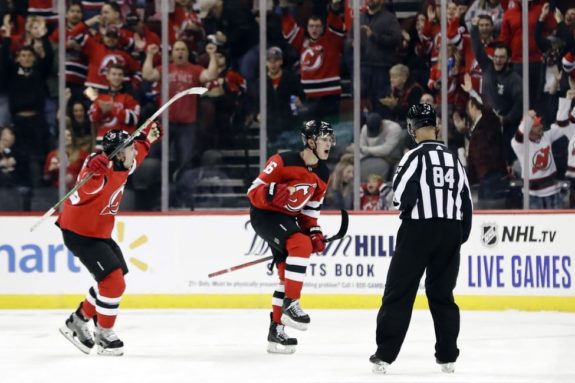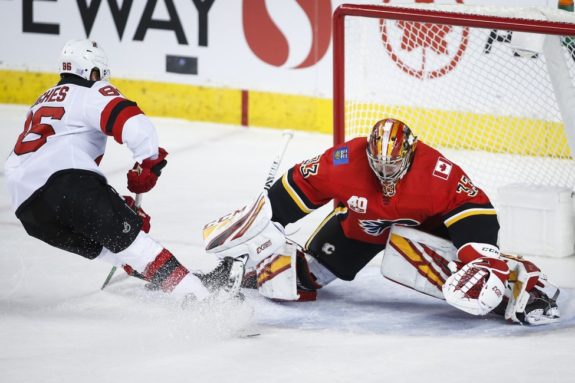Despite the results in the standings, the New Jersey Devils have a lot going for them. They have been in rebuild mode for a while now, and their efforts are starting to come to fruition. Young and exciting players have recently made their way to Jersey as the club inches closer and closer to becoming competitive, and the flurry of moves made by general manager Tom Fitzgerald this offseason confirms that the Devils are making good progress. But no trade, signing, or draft pick can substitute for the most important aspect of the team’s rebuild: the development of Jack Hughes.
Make no mistake, Hughes is indeed the Devils’ most valuable asset. In a league that values offensive production more and more, investing the team’s first-overall pick in a playmaking forward must have grand returns if they expect to find success in the near future. Let’s be honest – fans and management alike would be disappointed if the youngster develops into anything less than a first-line forward. Such is the nature of being the top pick in the NHL draft, especially after averaging over two points per game in two seasons with the U.S. National U18 team.
New Jersey is building around Hughes and fellow center Nico Hischier, who each have time to reach their ceiling. But if the former – who, quite frankly, has much more potential – should falter, a major wrench will be thrown into the construction of the roster. Simply put, Hughes must fulfill his potential if the Devils are to become playoff contenders any time soon. No pressure, kid.
Hughes’ sophomore season in 2020-21 was an improvement over his rookie campaign, but was it enough?
An Underwhelming Rookie Season
From the moment Hughes stepped on the ice in black and red, we knew he had skills. Hell, it was obvious in the numerous highlights we saw in the season leading up to the 2019 NHL Draft, which spawned the catchphrase “#loseforHughes.” To put a label on his skating style, I like to say that he glides around the ice. But even that description may do a disservice to the select few who can fly around the rink with unreal speed, creativity, and grace as he does. Watching the rookie was almost always a treat whenever those skates got moving.

But his raw skating ability and flashes of playmaking weren’t quite enough to put together an all-around impressive first season. Hughes scored only seven goals and 14 assists in 61 games in 2019-20, a pretty underwhelming total considering his most familiar linemates were Taylor Hall and Kyle Palmieri. While Hall’s superstar status, Palmieri’s gritty finishing style, and the raw skill of Hughes may have sounded like a Devils fan’s dream, it just didn’t work out for the then-18-year-old. Why, though?
Well, to be fair to Hughes, stability wasn’t a Devils’ staple that season. Head coach John Hynes was fired in the middle of the campaign, and Hall was dealt before the trade deadline to the Arizona Coyotes. Hughes found himself bounced between a plethora of different line combinations throughout the season and even took some reps on the wing.
There was also the fact that Hughes was making the jump from playing against children to playing against men. Entering the NHL without any prior professional experience is a daunting task for any player, let alone the 5-foot-10, 168-pound teenager who plays center. His lack of size and experience likely had more impact than any line combination. Watching him, you could tell that he lacked in the strength department; he often took the rough end of a big hit and had trouble winning puck battles like these:
That didn’t bode well for him defensively. According to Evolving Hockey, Hughes’ defensive goals above replacement (DEF) was in the negative at -2.4 in 2019-20, which makes sense given his lack of strength and the expected struggles that come with being a rookie. Some might argue that Hughes was drafted to put up points, not to be a defensive maestro, and that’s true, but arguably his most dangerous asset is his transition game, and a big part of transition offense is taking the puck away from your opponent – but more on that later.
No Sophomore Slump Here
Following his initial season, critics were quick to doubt Hughes’ potential to fulfill the expectations of a first-overall pick. Many pointed out that he had produced one of the worst statistical seasons for a player of his draft position in recent seasons, but hey, not everyone can be Connor McDavid or Auston Matthews out of the gate. If anything, his second season in the NHL was a sign that superstardom would come sooner than later. Even before the season began, some good news broke:
Hughes and the Devils clearly saw what fans did and identified his size and strength as the issue. The 14 pounds of muscle added in the offseason immediately made a difference, too. In the Devils’ opener against the Boston Bruins in 2020-21, one noticeable display of power led to the game-tying goal in the third period.
In the timestamped video above, Hughes hounds Boston forward Sean Kuraly as he curls off of the boards with the puck, not only stripping him and setting up a breakaway for Miles Wood but motoring past Kuraly and forcing him to take a penalty. As a rookie, he simply didn’t show that kind of strength. The weight Hughes put on helped him throughout 2020-21, with improved puck battles and in handling contact better on the rush and behind the net.
In conjunction with improvements in the strength department, Hughes showed enhanced defensive skills. Flipping his numbers from the season before, he improved his DEF from -2.4 to 2.3. In fact, he impressively finished second in the league with 56 takeaways, which undoubtedly played a part in the uptick in individual scoring chances from his rookie season. According to Natural Stat Trick, in 2020-21, Hughes recorded 151 such scoring chances, 20 more than in his rookie season (in five fewer games) and more than Hall (between the Buffalo Sabres and Bruins) and Boston’s Brad Marchand. Long story short, playing better defense meant the puck was on his stick more often, and the result was a higher quality offense.
Again, from a purely statistical standpoint, Hughes’ second season wasn’t a traditional breakout campaign. With 11 goals and 20 assists, he was only on pace for a 45-point effort in a full 82-game schedule. But besides the underlying numbers that show overall development, any sheltered minutes he enjoyed in year one were practically nonexistent in year two. Due to injury, Hischier only played in 21 games last season, which meant Hughes was the top center for most of the campaign. His average ice time jumped from 15:52 to 19:04 between seasons, usually flanked by new Jersey’s most compatible winger duo in Janne Kuokkanen and Yegor Sharangovich. These weren’t easy minutes for Hughes, but instead of shrinking away from the challenge, the 19-year-old showed improvement in his game across the board.

Maturity also played a big part in his second season. In many instances, Hughes utilized patience when he had the puck. Gone were his bad habit of throwing the biscuit into the slot when there wasn’t a play to be made or the tendency to blaze through the neutral zone at full speed with every opportunity. Instead, he deceptively changed speed and direction as he skated in on the attack. In the offensive zone, he eliminated wasted possession by shooting a team-leading 142 shots. Perhaps most importantly, Hughes was more consistent with his production than he was in his rookie year when he went through four stretches of six-plus games without recording a point. This past season, he only had one such stretch and, besides that, never had a scoreless streak of more than three games.
All in all, Hughes was a much better player in his second season. While his point totals weren’t impressive, his performance was. At times, he was the sole driver of the Devils’ offense and looked every bit as effective as any NHL star. Against the New York Rangers on Jan. 19, Hughes dominated the game and easily could have doubled his three-point night. For those who don’t remember it, here’s a reminder of what Hughes can do when he combines his newfound patience and grit with his elite skill:
You’d be hard-pressed to find an area where Hughes did not improve in his second season. Like his DEF, his offensive goals above replacement also turned a negative figure into a positive one (-3 to 3.7). His shots were up. His shooting percentage jumped a couple of points to 7.7%. He created more scoring chances, drew more penalties (19), and nearly led the NHL in takeaways.
As a rookie, Devils fans saw a skater brimming with raw talent who needed to find his game. As a sophomore, they saw a player who had applied himself and found that game but needed to find a way to play it more consistently. That is very encouraging progress.
The Next Step
So, where does Hughes go from here? What needs to happen for him to become the bonafide first-line center that the Devils sorely need?
Well, a few things. Hughes needs to become a more accurate shooter, and that fact cannot be understated. Hughes outshot the next closest Devil by 15 last season, yet the three highest-volume shooters behind him all potted at least 16 goals. That’s because, between the three of them (Sharangovich, Miles Wood, and Pavel Zacha), they averaged a 14.6% shooting percentage compared to Hughes’ 7.7%. If he had shot at that clip, he might have scored 20 goals. He needs to become a better finisher on plays like this:
Adding more size won’t hurt, either. While Hughes exhibited better strength in his second season, nobody would consider him above average in that area. If he continues to bulk up, it’ll only become easier to win battles and stave off opponents as he drives the offense. Speaking of easier, you can also expect a spike in point production once the Devils surround their top center with better talent. No offense to Kuokkanen or Sharangovich, but if the team is to become a contender, those two can’t be the first-line wingers. Will Tomas Tatar help Hughes out? Can Alexander Holtz become the elite finisher the team desperately needs? Is a big trade on the horizon? We’ll have to wait and see.
Most important of all, though, is consistency. We know that Hughes can take over a game and singlehandedly drive the Devils’ offense. We’ve seen it. The issue is that we need to see that version of Hughes in more games than not. It’s a huge ask for a player who is only 20 years old, but at least we know time is on his side when it comes to realizing his potential. If last season’s jump is any indication, we could see a much better player come October.
For opposing teams, that’s a scary thought.